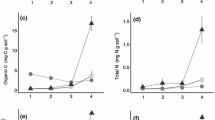Abstract
Regeneration of nutrients from relatively nutrient-poor organic residues is essential for overall operation of an ecosystem. Nutrients thus released are, however, inadequate for the needs of the decomposer populations, and a much faster nutrient turnover involving bacterial immobilization and release occurs concurrently. Evidence from aquatic ecosystems indicates that bacteria release little phosphorus, for which they have high demand, whereas bacterial grazers play an important role in regeneration of bacterial phosphorus. Our studies extend these relationships to terrestrial ecosystems. We studied phosphorus immobilization and mineralization in soil incubations, simulating rhizospheres with combinations of bacterial, amoebal, and nematode populations. Bacteria quickly assimilated and retained much of the labile inorganic phosphorus as carbon substrates were metabolized. Most of this bacterial phosphorus was mineralized and returned to the inorganic phosphorus pool by the amoebae. Nematode effects on phosphorus mineralization were small, except for indirect effects on amoebal activity. The observed remineralization may reflect direct excretion by the amoebae, physiological effects on the bacterial populations, or both. These results suggest a major role of microfauna in nutrient cycling.
Similar content being viewed by others
References
Anderson, R. V., E. T. Elliott, J. F. McClellan, D. C. Coleman, C. V. Cole, and H. W. Hunt: Trophic interactions in soils as they affect energy and nutrient dynamics. III. Biotic interactions of bacteria, amoebae, and nematodes. Microb. Ecol. (this volume)
Barsdate, R. J., R. T. Prentki, and T. Fenchel: Phosphorus cycle of model ecosystems: significance for decomposer food chains and effect of bacterial grazers.Oikos 25, 239–251 (1974)
Bowman, R. A., and C. V. Cole: Transformations of organic phosphorus substrates in soils as evaluated by NaHCO3 extraction. Soil Sci.125, 49–54 (1978)
Bowman, R. A., and C. V. Cole: Estimation of microbial P in soils using a CHCl3 treatment technique. (in preparation)
Cole, C. V., G. S. Innis, and J. W. B. Stewart: Simulation of phosphorus cycling in semiarid grasslands. Ecology58, 1–15 (1977)
Coleman, D. C., R. V. Anderson, C. V. Cole, E. T. Elliott, L. Woods, and M. K. Campion: Trophic interactions in soils as they affect energy and nutrient dynamics. IV. Flows of metabolic and biomass carbon. Microb. Ecol. (this volume)
Coleman, D. C., C. V. Cole, R. V. Anderson, M. Blaha, M. K. Campion, M. Clarholm, E. T. Elliott, H. W. Hunt, B. Shaefer, and J. Sinclair: An analysis of rhizosphere-saprophage interactions in terrestrial ecosystems. Soil Organisms as Components of Ecosystems. Ecol. Bull. (Stockh.)25, 299–309 (1978)
Fenchel, T.: The significance of bactivorous protozoa in the microbial community of detrital particles. In: J. Cairns (Ed.): Aquatic Microbial Communities, pp. 529–544. Garland Publishing, New York (1975)
Fenchel, T., and P. Harrison: The significance of bacterial grazing and mineral cycling for the decomposition of particulate detritus. In: J. M. Anderson and A. Macfadyen (Eds.): The Role of Terrestrial and Aquatic Organisms in Decomposition Processes, pp. 285–289. Blackwell Scientific Publications, Oxford (1976)
Hayman, D. S.: Phosphorus cycling in soil microorganisms and plant roots. In: N. Walker (Ed.): Soil Microbiology, pp. 67–91. Halsted Press, John Wiley & Sons, New York (1975)
Johannes, R. E.: Influence of marine protozoa on nutrient regeneration. Limnol. Oceanogr.10, 434–442 (1965)
Johannes, R. E.: Nutrient regeneration in lakes and oceans. Adv. Microbiol. Sea1, 203–213 (1968)
Olsen, S. R., C. V. Cole, W. S. Watanabe, and L. A. Dean: Estimation of available phosphorus in soils by extraction with sodium bicarbonate. USDA Circ. No. 939. Washington, D.C. (1954)
Pomeroy, L. R.: The strategy of mineral cycling. Annu. Rev. Ecol. Syst.1, 171–190 (1970)
Pomeroy, L. R.: The ocean's food web, a changing paradigm. BioScience24, 499–504 (1974)
Rovira, A. D.: Interactions between plant roots and soil microorganisms. Annu. Rev. Microbiol.19, 241–266 (1965)
Watanabe, F. S., and S. R. Olsen: Test of an ascorbic acid method for determining phosphorus in water and NaHCO3 extracts. Soil Sci. Soc. Am. Proc.29, 677–678 (1965)
Author information
Authors and Affiliations
Rights and permissions
About this article
Cite this article
Cole, C.V., Elliott, E.T., Hunt, H.W. et al. Trophic interactions in soils as they affect energy and nutrient dynamics. V. Phosphorus transformations. Microb Ecol 4, 381–387 (1977). https://doi.org/10.1007/BF02013281
Issue Date:
DOI: https://doi.org/10.1007/BF02013281




